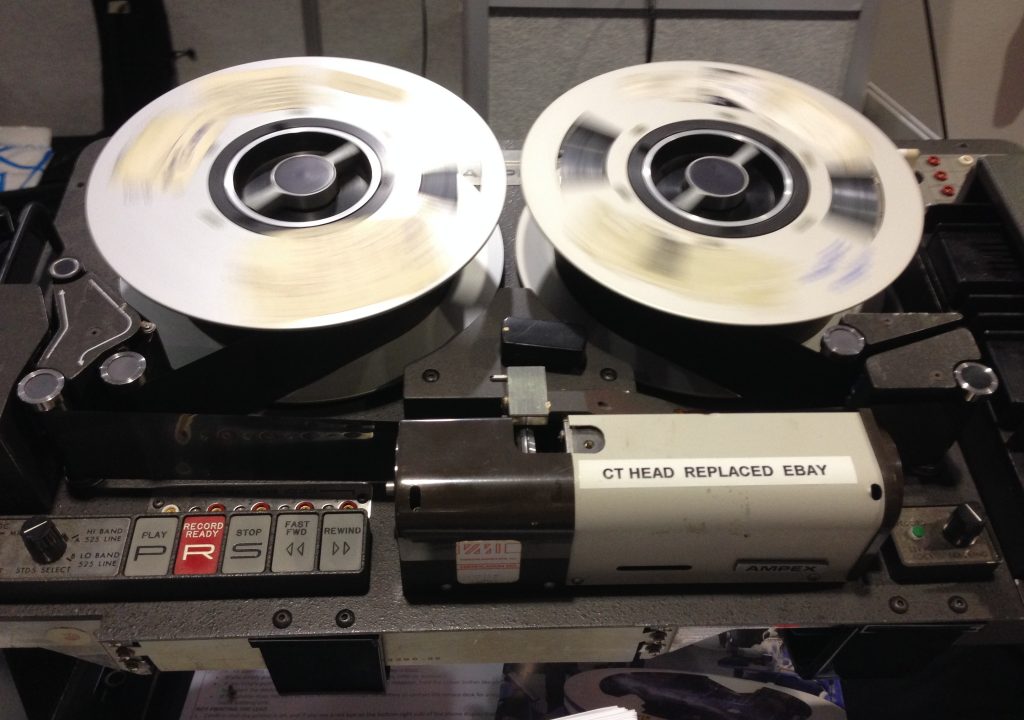As the NAB Show opened and most attendees scrambled to get up to speed on the future of IP, 4K and HDR video from companies showing their latest and greatest, I made a trip back in time by looking for equipment from the RCA Broadcast Division and Ampex Corporation – broadcast gear from the 50’s, 60’s and 70’s still working all these decades later.
And there it was – snuggled in the Museum of Broadcast Technology (MBT) booth near an entrance to the North Hall. Three RCA TK-45 “handheld” cameras (1974) and an Ampex 3000B portable quadruplex videotape recorder (1967 for the 3000, 1970’s for the B model) with two-inch wide tape running along its tape path, all in their full operational glory. In fact, the group has set up a full portable three camera remote. They were the highlights among various items of vintage analog gear from the early years driven to Las Vegas from the museum’s home base in Woonsocket, Rhode Island, by two members of the museum’s team.
The TK-45’s were fired up and making pictures. But there’s a reason the word “handheld” is in quotes in the previous paragraph. “Bodyheld” would be more accurate. An operator literally had to wear the camera. And it wasn’t light. My back begins to ache just thinking of walking up and down the sideline of an entire football game, crouching, bending and running.
https://www.youtube.com/watch?v=QNHGE5kDfL4
The video tape recorder, the Ampex VR3000B, a second generation model of the first portable VTR. “Portable” in that it could be strapped to a strong crew member and carried backpack style. This was not the “run-and-gun” we are used to today. The portability of this equipment could not be accomplished by one person. However, being able to mount it all in a station wagon was a great step forward at the time.
I talked to Tom Sprague and Paul Beck, two of the founders of the Museum. It is a labor of love for all concerned but both are very passionate about ensuring a legacy is passed on to future generations. Tom told me how much of the equipment has been rescued from obscure places like basements, garages, attics and even chicken coops!
MBT has been bringing working examples of television’s early technology to NAB for several years now. Their booth space is donated by NAB as they aren’t there to sell anything. only to inform and educate. The MBT’s founding fathers’ only interest in addition to keeping the equipment alive is in keeping its history alive. What better instructional tool than to be able to put your hands on the actual equipment that supported an industry that grew from experimental to world phenomenon in just a few years and changed world culture forever?
It’s appropriate they displayed an Ampex recorder at this particular show. This year is the 60th anniversary of the unveiling of the first broadcast quality video tape recorder to the world. At the yearly NAB show on March 14, 1956, near pandemonium broke out when a group of television professionals realized the program on monitors around the room were showing a speech they had seen live only moments before.
It’s hard to imagine for us today how different television was back then. In those days, network shows on the west coast of the United States were seen either from poor quality reproductions shot off a TV monitor by a 35mm or 16mm film camera (kinescopes) or live as the crew and performers did two shows – the first for the US east and central time zones and then again two hours later for the western time zones.
Many markets still only had one or two television stations at that time. Stations in markets with less stations than there were networks would affiliate with more than one network. They would take one network’s show live and then run the poorer quality kinescope film of a competing network in another time slot. Video tape changed that almost overnight as kinescopes were replaced by tape’s high quality, almost live look.
Early Ampex video tape machines, all of them hand built prototypes, first went to the three commercial networks where they were immediately put to work doing time zone delays for the west coast, substantially improving picture quality for viewers in that part of the country. As Ampex was able ramp up an assembly line, the prototype designs were refined and the first production model was designated the VR-1000. This black and white only machine, started rolling off the new Ampex assembly line in 1957.
Ampex continued to make refinements on the machines and in 1959 the B model was born. One of its major advancements was the addition of color record and playback capabilities. In February of this year, MBT succeeded in bringing their Ampex VR-1000B back to life. When he saw it working, James O’Neal, technology writer for TV Technology thought it should be present in MBT’s booth this year to commemorate the milestone anniversary. The MBT began a “gofundme” page to cover the expenses of crating the behemoth machine but the amount they were able to raise fell short as time ran out. Tom and Paul have high hopes for next year, though. So the gofundme project continues for the 60th Anniversary of the release of the VR-1000, the first production model.
It would be a high point of the show. The early VTR’s were the epitome of “Big Iron” – monster pieces of equipment that required special power, air compressors and tender loving care to reproduce television programs. It would be fun, educational and to some, nostalgic to see it in operation at next year’s NAB. It you’re interested in helping make that possible, MBT’s gofundme site is www.gofundme.com/wmbtorg . Be sure to check out the video tour of the Museum’s restored VR-1000B.

